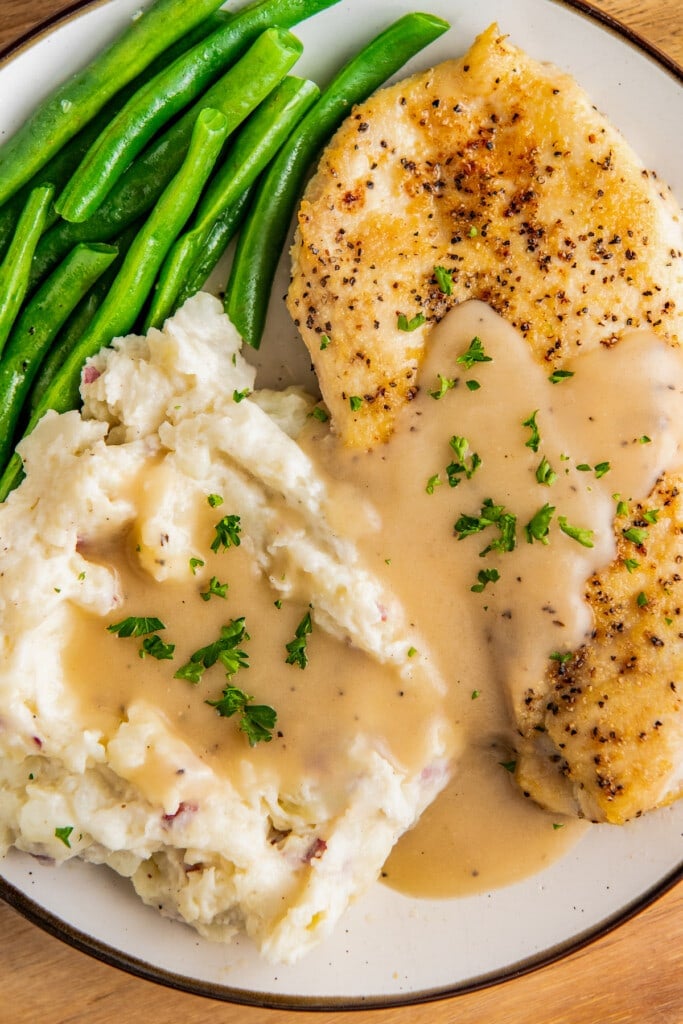Have you ever made a big batch of delicious chicken gravy only to wonder if it’s still good to eat a few days later? We’ve all been there! As someone who regularly cooks for my family, I understand the importance of making the most of your homemade gravy without risking anyone’s health.
In this article I’m gonna share everything you need to know about storing that liquid gold we call chicken gravy. From refrigeration to freezing and how to tell when it’s time to sadly toss it in the trash, we’ve got you covered!
The Short Answer: Shelf Life of Homemade Chicken Gravy
Let’s cut to the chase! Homemade chicken gravy typically lasts:
- Refrigerated: 3-4 days when stored properly
- Frozen: 2-3 months without significant quality loss
Remember, these timeframes are for properly stored gravy in airtight containers. Don’t leave that gravy sitting out on the table for hours after dinner!
Understanding What Affects Your Gravy’s Lifespan
Not all gravies are created equal, and several factors can influence how long your homemade chicken gravy remains safe to eat.
Ingredients Matter
The components of your gravy directly impact its shelf life. Here’s what you should know:
-
Dairy-based gravies: Gravies containing cream, milk, or butter tend to spoil faster than others. These dairy components make the gravy more susceptible to bacterial growth.
-
Simple flour/broth gravies: Gravies made with just chicken broth and flour or cornstarch typically last a bit longer than dairy-rich versions.
I personally prefer making my gravy with a roux (butter and flour) and chicken stock, which gives me a few solid days of leftover enjoyment.
Storage Conditions Are Crucial
How you store your gravy after making it plays a HUGE role in its longevity:
-
Rapid cooling: Letting your gravy cool at room temperature for hours is a big no-no! The longer it sits in the “danger zone” (40°F-140°F or 4°C-60°C), the greater the risk of bacterial growth.
-
Airtight containers: Using proper storage containers prevents cross-contamination and absorption of other food odors.
-
Refrigerator temperature: Make sure your fridge is set below 40°F (4°C) to slow bacterial growth.
Initial Preparation and Handling
How you make and handle your gravy from the get-go affects how long it’ll last:
-
Clean utensils: Using contaminated spoons or other tools can introduce bacteria right from the start.
-
Thorough cooking: Properly cooking the gravy kills most bacteria initially present.
-
Minimal contamination: Every time you dip into that gravy container, you’re potentially introducing new bacteria. Try to portion out what you need rather than repeatedly accessing the main storage container.
Signs Your Chicken Gravy Has Gone Bad
Nobody wants to serve spoiled gravy to their family or guests! Here’s how to tell if your homemade chicken gravy has gone bad:
Visual Clues
- Mold growth: Any sign of mold (even tiny spots) means the entire batch should be discarded.
- Unusual color changes: If your gravy has darkened significantly or developed strange discoloration, it’s time to say goodbye.
- Texture changes: Has your gravy become slimy, excessively thick, or separated in a way that stirring doesn’t fix? That’s a warning sign!
Smell Test
Trust your nose! If your gravy has:
- A sour smell
- Rancid odor
- Any unusual or “off” aroma
…then don’t risk it. When in doubt, throw it out!
Taste (with caution)
If the gravy passes the visual and smell tests but you’re still unsure, you can taste a tiny amount. If it tastes sour, bitter, or just “off” in any way, discard it immediately.
I once ignored a slightly weird smell from my Thanksgiving gravy, thinking it was just the herbs I’d added. Big mistake! Several family members complained of stomach issues later. Lesson learned!
Best Practices for Storing Homemade Chicken Gravy
Refrigeration (3-4 Days)
Follow these steps to maximize your gravy’s refrigerated shelf life:
-
Cool it quickly: Transfer hot gravy to shallow containers to speed cooling. Large, deep containers take too long to cool, keeping the gravy in the danger zone.
-
Use proper containers: Store cooled gravy in airtight glass or plastic containers. I prefer glass containers as they don’t absorb odors or stain like plastic sometimes can.
-
Label and date: Mark your container with the date you made the gravy. This helps track how long it’s been stored.
-
Position in refrigerator: Store gravy on refrigerator shelves rather than in the door, where temperatures fluctuate more.
-
Don’t leave at room temperature: Never leave gravy out for more than 2 hours (or 1 hour if your room is over 90°F/32°C).
Freezing (2-3 Months)
For longer storage, freezing is your friend:
-
Cool completely first: Always cool gravy before freezing to prevent ice crystals and texture changes.
-
Use freezer-safe containers: Leave some headspace in containers as gravy will expand when frozen.
-
Portion before freezing: Freeze gravy in meal-sized portions so you only thaw what you need.
-
Consider ice cube trays: For small portions, freeze gravy in ice cube trays, then transfer the frozen cubes to a freezer bag.
-
Label clearly: Mark containers with contents and date.
I’ve found that frozen gravy can sometimes separate when thawed, but a good whisking while reheating usually fixes this problem!
Thawing and Reheating Frozen Chicken Gravy
Safe Thawing Methods
-
Refrigerator thawing: The safest method! Transfer frozen gravy to the refrigerator and let it thaw overnight.
-
Cold water thawing: If you’re in a hurry, place the sealed container in cold water, changing the water every 30 minutes until thawed.
-
Microwave thawing: Use the defrost setting, but plan to use the gravy immediately after thawing.
Reheating Tips
-
Stovetop reheating: Place thawed gravy in a saucepan and heat over medium-low heat, stirring frequently until it reaches a temperature of 165°F (74°C).
-
Microwave reheating: Heat in short intervals, stirring between each to ensure even heating.
-
Fixing separated gravy: If your gravy separates after freezing, whisk vigorously while reheating. If needed, add a small amount of cornstarch slurry (cornstarch mixed with cold water) to help bind it back together.
FAQs About Homemade Chicken Gravy Storage
Can I leave chicken gravy out overnight?
Absolutely not! Leaving gravy at room temperature for more than 2 hours creates a perfect environment for bacterial growth. The USDA identifies the temperature range between 40°F and 140°F (4°C and 60°C) as the “danger zone” where bacteria multiply rapidly.
Does using cornstarch instead of flour make gravy last longer?
The choice between cornstarch and flour as a thickener has minimal impact on shelf life. What matters most is proper storage and handling! Whether you prefer the silky texture of cornstarch gravy or the traditional flavor of flour-based gravy, the storage guidelines remain the same.
Can I reheat chicken gravy multiple times?
It’s best to avoid repeatedly reheating the same batch of gravy. Each time gravy is heated and cooled, it passes through the temperature danger zone, increasing contamination risk. Instead, only reheat the portion you plan to use.
What’s the best container for storing gravy?
Glass or BPA-free plastic containers with tight-fitting lids are ideal. Glass doesn’t absorb odors or stains, while quality plastic containers are lightweight and less prone to breakage. Whichever you choose, make sure it’s airtight!
How do I quickly cool gravy before refrigerating?
Transfer hot gravy to shallow containers and place them in an ice bath (a larger bowl filled with ice water). Stir occasionally to release heat. Never put hot gravy directly in the refrigerator, as this can raise the internal temperature of your fridge, potentially compromising other foods.
Can I freeze gravy containing cream or milk?
Yes, but be prepared for some texture changes. Dairy-based gravies may separate or become slightly grainy after thawing. Vigorous whisking during reheating often restores the texture, but it might not be quite as smooth as fresh gravy.
My Personal Tips for Extended Gravy Life
After years of making gravy for family gatherings, I’ve picked up a few tricks:
-
Make a double batch: When I’m already going through the effort of making homemade gravy, I often make extra specifically for freezing. It’s a time-saver for future meals!
-
Slightly underthicken for freezing: Gravy that’s slightly thinner freezes and reheats better than very thick gravy. You can always thicken it more when reheating.
-
Freshen up older gravy: If your refrigerated gravy is nearing the 3-day mark but still looks and smells fine, bring it to a full boil when reheating to kill any developing bacteria. Add a splash of fresh broth to reinvigorate the flavor.
-
Silicone molds for freezing: I love using silicone muffin tins for freezing perfect single-serving portions of gravy.
When to Play It Safe
Even if your gravy doesn’t show obvious signs of spoilage, it’s always better to err on the side of caution. Food safety experts consistently advise discarding gravy after 3-4 days in the refrigerator, regardless of how it looks or smells.
Remember that food poisoning isn’t worth the risk, especially for vulnerable family members like young children, pregnant women, elderly relatives, or anyone with a compromised immune system.
Final Thoughts
Homemade chicken gravy is a delicious addition to many meals, and knowing how to properly store it helps reduce food waste while keeping your family safe. The key takeaways:
- Refrigerated homemade chicken gravy lasts 3-4 days
- Frozen gravy maintains quality for 2-3 months
- Always cool gravy quickly before storing
- Use airtight containers and label with dates
- Trust your senses—if it looks or smells off, don’t eat it!
Next time you whip up a batch of delicious homemade chicken gravy, you’ll know exactly how to make it last. What’s your favorite dish to serve with chicken gravy? I’d love to hear about it in the comments below!
Do you have any special tips or tricks for storing gravy that I missed? Share your wisdom with our community and help everyone make the most of their homemade sauces!

Short-Term Gravy Storage
Unfortunately, gravy begins to separate if you hold it for too long. To preserve the quality, refrigerate any leftover gravy promptly and use it within two days. After that time, you can boil any remaining gravy for three minutes to kill any bacteria, and then store it for another two days. You can follow this two-day process for up to a week, but you might find it easier to freeze the gravy in manageable portions.
Long-Term Freezer Storage
If you plan to freeze some of the gravy before you make it, try to use as little fat, milk, or cream as possible when you prepare it, as those ingredients tend to separate during the thawing process. You can also significantly reduce the chance of separation if you run the gravy quickly through a blender or food processor before you package it for freezer storage.
Spoon the gravy into freezer bags, airtight containers, or ice cube trays (for use in smaller amounts in the future) before you freeze it. Flour-thickened gravy can remain frozen in an airtight container for up to four months without a noticeable loss in quality. Thaw frozen gravy in the refrigerator overnight, then reheat it slowly in a saucepan over medium-low heat, whisking constantly to prevent lumps. Add a bit of water or stock if it seems too thick, or if the gravy separated. You may be able to pull it back together with a little extra liquid and some vigorous whisking. If you happen to have leftover roast or turkey that you would also like to freeze, package it in combination with the gravy for the best results. Cooked meats store and freeze better in their own gravy as it keeps the meat from drying out. Reheat meat-and-gravy combination dishes in a 350 F oven until it registers a temperature of 160 F in several places. Use frozen meat-and-gravy combinations within three months.
